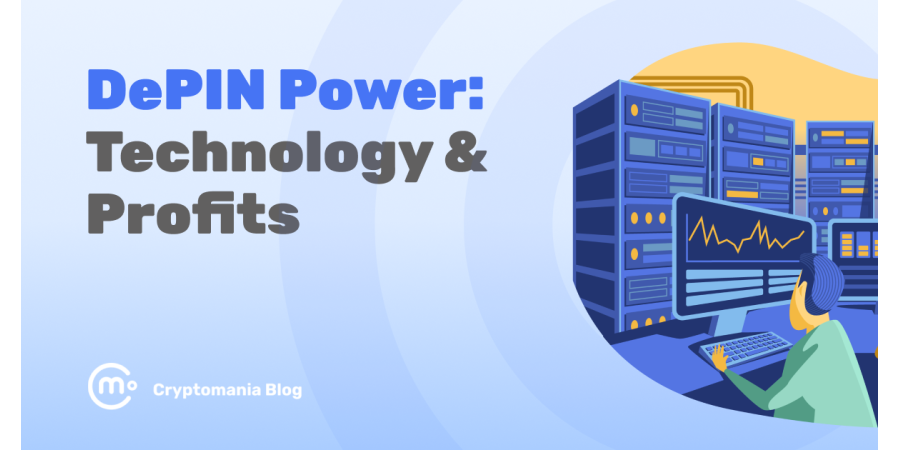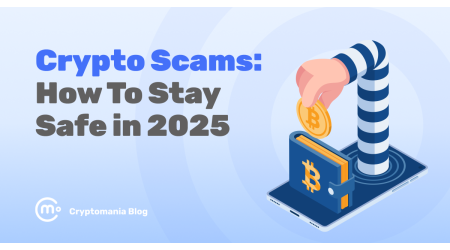

DePIN projects are on fire right now. Their market cap jumped 22.7% in just the past month, while most other sectors are struggling. But that’s just a small piece of the story.
Over the last year, DePIN’s market cap has skyrocketed by 400%, hitting $20 billion, with fundraising up nearly 300% year-over-year. Investors and developers are all-in, betting big on what’s shaping up to be one of the most exciting areas in crypto.
And the buzz is real. More projects are diving into the DePIN space, and it’s not just the developers who see the massive potential—investors are backing them up in a big way.
Curious about what’s behind all this hype? Let’s break down what DePIN is, how it works, its pros and cons, and where it could be headed next.
What is DePIN in simple words?
DePIN stands for a Decentralized Physical Infrastructure Network.
The DePIN concept involves the use of blockchain technology to create, support, develop, and use physical infrastructure networks.
That is, DePIN combines blockchain technology with physical infrastructure. How does it work? Everything is tied to suppliers and consumers. Suppliers contribute computing power, storage capacity or other resources to the network, receiving platform tokens as a reward.
Consumers pay tokens and receive resources in return, delivered through a decentralized network. It is similar to a simple purchase in a store, only instead of goods there are digital resources, and instead of a cash register there is a blockchain.
Crypto helps people interact and solves even complex problems such as the supply of computing power and resources.
Types of DePINs: PRNs and DRNs
DePINs come in two main types: Physical Resource Networks (PRNs) and Digital Resource Networks (DRNs). This classification helps highlight the various applications and advantages of DePINs in different areas. Let’s see what each of them means and then understand how DePINs work.
Physical Resource Networks (PRNs)
Physical Resource Networks (PRNs) use tangible assets like hardware, infrastructure, and physical goods to provide services within a decentralized system. These networks rely on community-owned physical resources and encourage individuals to contribute their assets, which helps the network operate and grow.
Digital Resource Networks (DRNs)
Digital Resource Networks (DRNs) operate using digital assets and services. They rely on resources such as data, computing power, and digital services. DRNs aim to make the most of decentralized digital resources, motivating participants to contribute their digital assets to the network.
Understanding DePIN mechanics
DePIN connects physical facilities to the blockchain. In simple terms, the system has three key parts: a physical location managed by a provider, software that connects this location to the blockchain, and a public record that tracks payments. Here’s how it works with these three main elements.
The physical facility could be anything like a sensor, an internet router, or a solar panel, managed by a private provider. Sometimes, these providers already own these facilities before joining a DePIN project. Just like in a Proof of Work (PoW) blockchain where miners contribute computing power to secure the network, many private providers can contribute their facilities to a DePIN.
The middleware acts as the bridge between the physical infrastructure and the blockchain. It works like a decentralized oracle network (DON) that collects data from the real world and communicates it to a blockchain application. The middleware gathers data on what each private facility is doing and sends it to the DePIN network.
And finally, the blockchain system receives the data from the middleware and acts as the manager, handling payments for providers and users. It allocates demand across providers based on the data and calculates rewards, which are paid in cryptocurrencies. For users, the blockchain also manages resource purchases, ensuring that pricing is integrated into the payment system and users are charged correctly for the services they use.
DePIN benefits & drawbacks
Here are some of the potential advantages and challenges of DePIN.
Benefits of DePIN
- Scalability DePINs allow networks to expand resources flexibly. When demand is high, more facilities can be added without major changes, making it easy to scale up or down as needed.
- Decentralization and community control. Control is distributed among many providers, not just one company. This makes the system more democratic, with each provider contributing and having a say in operations.
- Suitable pricing. Prices in DePINs are generally more transparent and fair, as they are based on the actual costs of running the facilities, with fewer markups than traditional centralized systems.
- Cost efficiency. DePINs operate with minimal costs, as providers can share resources across multiple networks. Users also benefit from fair pricing for the services they use.
- Open participation. Anyone with the necessary infrastructure can contribute to a DePIN, and users can access services without complicated processes or negotiations.
- Incentives for providers. Providers can earn income by contributing their resources, including those that would otherwise be unused, creating a potential new revenue stream.
Drawbacks of DePIN technology
- Early adoption challenges. DePIN is still a new concept, and currently, only a small number of people and businesses are involved. This can make it difficult to attract enough providers and users to grow the network.
- Technical complexity.The technology behind DePINs can be hard to understand, which may deter potential participants. Education and clear communication are needed to help more people get involved.
- Operational costs. Running the necessary infrastructure can be expensive for providers, especially without external financial support.
- Profitability concerns. For DePINs to be successful, they need to offer rewards that cover costs and provide profit. At this early stage, achieving this balance might be challenging as participation is still low.
Top DePIN crypto projects
Here are a few examples of DePIN crypto projects.
- Helium (HNT): Helium is a wireless network that allows users to build and maintain a global network of hotspots, providing low-power, long-range connectivity for IoT devices. Participants are rewarded with HNT tokens for contributing to the network.
Helium launched in June and quickly attracted 756,000 real users — not just wallet addresses — who transferred over 19.1 TB of data through its network. And here’s the kicker: most of these users probably don’t even realize they’re using blockchain technology. - Filecoin (FIL): Filecoin is a storage network that incentivizes users to offer unused storage space to create a distributed cloud storage system. Providers earn FIL tokens based on the amount of data they store and the quality of their service.
- Akash Network (AKT): Akash Network is a cloud computing marketplace where providers can offer computing resources and users can rent them. It enables peer-to-peer cloud services, offering a more affordable and decentralized alternative to traditional cloud providers.
- Render Network (RNDR): Render Network is a GPU rendering platform that connects users in need of GPU power for rendering graphics and animations with those who have idle GPUs. Contributors earn RNDR tokens for their computational contributions.
- Nodle (NODL): Nodle is a network focused on IoT (Internet of Things) connectivity. It uses smartphones as nodes to create a low-cost, energy-efficient network for IoT devices. Participants earn NODL tokens for contributing connectivity and data to the network, enabling various IoT applications without relying on traditional infrastructure.
The future of DePIN
This year is a crucial moment for the development of DePINs. More manufacturers are getting interested in combining real-world infrastructure with blockchain technology.
According to Messari, the market for DePINs is currently worth $2.2 trillion and could reach $3.5 trillion by 2028. Venture capital firms like Pantera, Multicoin Capital, and Coinbase are also investing heavily in DePIN projects.
The excitement around DePINs comes from their groundbreaking approach to infrastructure ownership. By using blockchain and cryptocurrency, DePINs encourage the creation and operation of decentralized infrastructures. Experts expect this innovative model to reshape how we manage infrastructure, transforming both digital and physical spaces over the next five years.
Final thoughts
DePINs democratize infrastructure by enabling community-based facility building, where everyone can contribute and earn rewards. This approach leverages blockchain and cryptocurrency to create a cost-effective system that benefits projects, providers, and users with fair pricing and decentralized control.
While promising, DePINs are still in their early stages and may face challenges, including potential rapid changes and exploitation by bad actors. It’s important to understand how these systems work and to conduct thorough personal research. We hope our blog was helpful enough to explain DePIN’s meaning, bring useful examples, and cover the most important aspects of DePIN.
FAQ
What are DePIN tokens?
DePIN tokens are digital assets that reward people for participating in decentralized infrastructure networks. You earn these tokens by providing resources or services to the network. Users can trade or use them within the network, helping to drive economic activity and support its growth.
How to make money with DePIN?
You can earn money with DePIN by contributing to the network’s infrastructure, such as providing renewable energy, computing power, or network coverage. In return, you receive tokens, which you can trade on cryptocurrency exchanges or use within the network, offering various ways to generate income.





